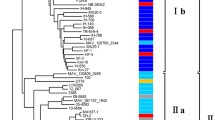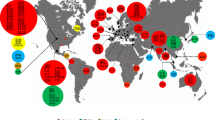Abstract
In this study, we epidemiologically investigated on clinical isolates of Arthroderma benhamiae from humans and animals in Japan by internal transcribed spacer (ITS) region sequence analysis and mating type (MAT)-specific PCR. Seven of 8 A. benhamiae isolates from a human, rabbits and guinea pigs were identified as group I (white phenotype) by morphological characters and ITS region sequence analysis. One strain isolated from a degus (Octodon degus) produced colonies with few irregular folds and yellow velvety mycelium without macro- and microconidia. This strain resembled to group II (yellow phenotype) strain. ITS sequence analysis was also 100 % identical to that of group II. MAT-specific PCR indicated that 6 of these 7 isolates of group I contained an alpha-box gene and that one strain contained high-mobility-group (HMG) gene. One strain of group II was revealed to have an alpha-box gene and no HMG gene. To our knowledge, it is the first A. benhamiae isolate of group II found in Japan. The A. benhamiae may be more widespread in worldwide than our surpassing what is common or usual or expected.


Similar content being viewed by others
References
Ajello L, Cheng S-L. The perfect state of Trichophyton mentagrophytes. Sabouraudia. 1967;4:230–4.
Felsenstein J. Confidence limits on phylogenies: an approach using the bootstrap. Evolution. 1985;39:783–91.
Hata Y, Amagai M, Naka W, Harada R, Nishikawa T. Two cases of Trichophyton mentagrophytes infection contracted from a hamster and a chinchilla. Nihon Ishinkin Gakkai Zasshi. 2000;41:269–73.
Hironaga M, Watanabe S. Mating behavior of 334 Japanese isolates of Trichophyton mentagrophytes in relation to their ecological status. Mycologia. 1980;72:1159–70.
Hiruma J, Kano R, Kimura U, Takamori K, Suga Y, Hiruma M, Hasegawa A, Tsuboi R. Mating type gene for isolates of Trichophyton mentagrophytes from guinea pigs. J Dermatol. 2014;41:743–5.
Kano R, Nakamura Y, Yasuda K, Watari T, Watanabe S, Takahashi H, Tsujimoto H, Hasegawa A. The first isolation of Arthroderma benhamiae in Japan. Microbiol Immunol. 1998;42:575–8.
Kano R, Sano A, Makimura K, Watanabe S, Nishimura K, Yamaguchi H, Hasegawa A. A new genotype of Arthroderma benhamiae. Med Mycol. 2008;46:739–44.
Kano R, Kawasaki M, Mochizuki T, Hiruma M, Hasegawa A. Mating genes of the Trichophyton mentagrophytes complex. Mycopathologia. 2012;173:103–12.
Kawasaki M, Inoue T, Ohsawa T, Ishioka S, Mochizuki T, Ishizaki H. Two Arthroderma benhamiae isolates showing mitochondrial DNA type of Trichophyton verrucosum. Nihon Ishinkin Gakkai Zasshi. 2002;43:103–6.
Kwon-Chung KJ, Bennett EJ. Dermatophytoses: medical mycology. Philadelphia: Lea & Febiger; 1992. p. 130–2 pp. 816–826.
Mochizuki T, Kawasaki M, Ishizaki H, Kano R, Hasegawa A, Tosaki H, Fujihiro M. Molecular epidemiology of Arthroderma benhamiae, an emerging pathogen of dermatophytoses in Japan, by polymorphisms of the non-transcribed spacer region of the ribosomal DNA. J Dermatol Sci. 2001;27:14–20.
Nenoff P, Krüger C, Ginter-Hanselmayer G, Tietz HJ. Mycology—an update. Part 1: dermatomycoses: causative agents, epidemiology and pathogenesis. J Dtsch Dermatol Ges. 2014;12:188–209.
Nenoff P, Uhrlaß S, Krüger C, Erhard M, Hipler UC, Seyfarth F, Herrmann J, Wetzig T, Schroedl W, Gräser Y. Trichophyton species of Arthroderma benhamiae: a new infectious agent in dermatology. J Dtsch Dermatol Ges. 2014;12:571–81.
Page RDM. TREEVIEW: an application to display phylogenetic trees on personal computers. Comput Appl Biosci. 1996;12:357–8.
Saito K, Kano R, Nakamura, Watanabe S, Hasegawa A. Arthroderma benhamiae infection in a rabbit. J Vet Med Sci. 2001;63:929–31.
Shiraki Y, Hiruma M, Kano R, Miyamoto C, Ikeda S. Case of tinea capitis caused by Trichophyton mentagrophytes (molecular type Arthroderma benhamiae): prevalence of a new zoonotic fungal infection in Japan. J Dermatol. 2006;33:504–6.
Stockdale MP, Mackenzie WRD, Austwick KCP. Arthroderma simii sp. nov., the perfect state of Trichophyton simii (Pinoy) comb. nov. Sabouraudia. 1967;4:112–23.
Symoens F, Jousson O, Packeu A, Fratti M, Staib P, Mignon B, Monod M. The dermatophyte species Arthroderma benhamiae: intraspecies variability and mating behavior. J Med Microbiol. 2013;62:377–85.
Takashio M. Observations on African and European strains of Arthroderma benhamiae. Int J Dermatol. 1974;13:94–101.
Takashio M. The Trichophyton mentagrophytes complex. In: Iwata K, editor. Recent advances in medical and veterinary mycology. Tokyo: University of Tokyo Press; 1977. p. 271–6.
Thompson JD, Higgins DG, Gibson TJ, Gibson TJ. CLUSTAL W: improving the sensitivity of progressive multiple sequence alignment through sequence weighting, position-specific gap penalties and weight matrix choice. Nucl Acid Res. 1994;22:4673–80.
Acknowledgments
This study was partly funded by Health, Labor and Welfare Sciences Research Grants for Research on Measures for Intractable Diseases (H25 shinko-ippan 006) from the Japanese Government.
Conflict of interest
The authors have no conflict interest.
Author information
Authors and Affiliations
Corresponding author
Rights and permissions
About this article
Cite this article
Hiruma, J., Kano, R., Harada, K. et al. Occurrence of Arthroderma benhamiae Genotype in Japan. Mycopathologia 179, 219–223 (2015). https://doi.org/10.1007/s11046-014-9839-0
Received:
Accepted:
Published:
Issue Date:
DOI: https://doi.org/10.1007/s11046-014-9839-0




